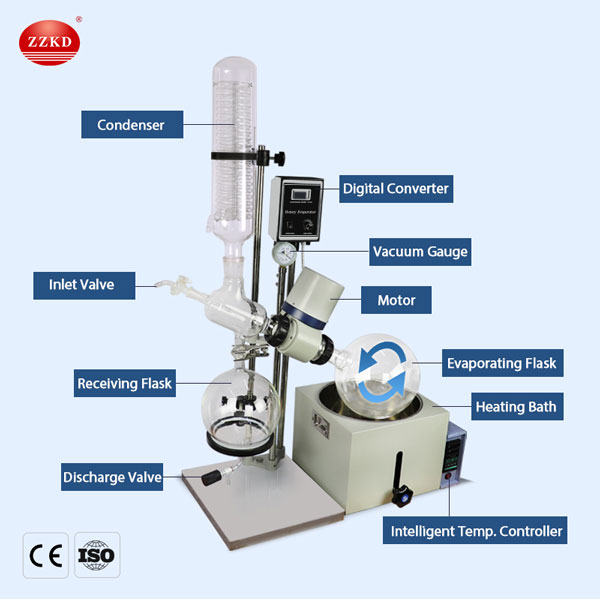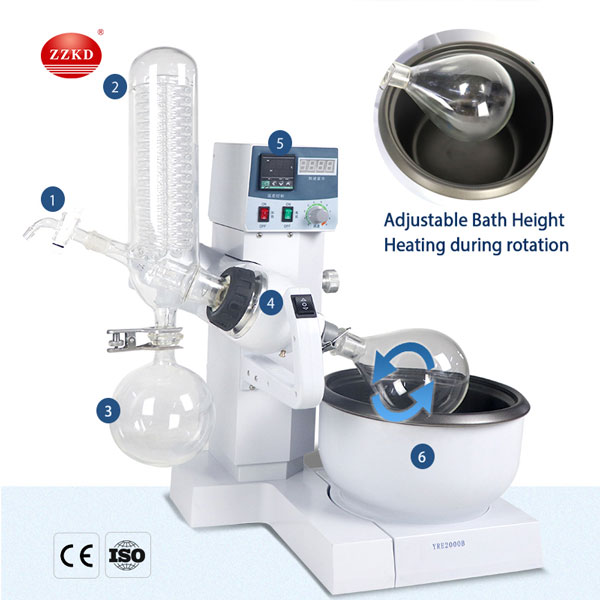Top Rotovap Receving Fask For Alcohol Extraction

Rotovap alcohol extraction process:
The main use of a rotary evaporator is to recover ethanol after the extraction process, also known as the winterization process. The process can also be used to recover many other solvents and to separate certain compounds.
Before starting the distillation, the mixture containing ethanol and extract must be separated. To do this, a vacuum is applied while heating, which causes the boiling point of ethanol to drop significantly. Slowly turn the evaporating flask so that the mixture forms a film on the inside of the flask. This speeds up the evaporation process by turning the ethanol into steam. This vapor is then drawn into the condenser by a vacuum pump.
As the vapor enters the condensation path, it re-condenses into a liquid and drips back into the flask. The extract remains in the evaporating flask while the ethanol goes into the collection flask. Any ethanol can then be reused for further extraction or winterization.

Precautions for Rotovap Alcohol Extraction:
1. Selection of rotary evaporator capacity:
The capacity here usually refers to the volume of the evaporating flask. Generally, the capacity of the rotary evaporator for ethanol extraction is within 5L. For example, 2L, 1L, 0.5L and smaller capacity rotovap receiving flasks can be selected. In addition, it can be adapted to a 50 liter rotary evaporator for continuous distillation of large-volume samples.
2. Select the appropriate condenser:
According to the requirements of condensation efficiency in the ethanol extraction experiment, a condenser with a suitable condensation area was selected. For condensers with the same size of condensation area, there are usually vertical condensers and inclined condensers on the market, and the condensation effects of the two are equivalent in terms of practical application effects.
3. The amount of sample added to the evaporating flask:
For example, the amount of ethanol added is about 1/3, generally not more than 1/2. During the rotation of the evaporating bottle, due to the centripetal force and friction between the ethanol liquid and the evaporating bottle, the ethanol liquid will form a surface on the inner surface of the evaporating bottle. Layer thin film, the appropriate amount of sample can make the film area reach, providing better distillation efficiency;
4. The heating temperature of the heating pot and the selection of the heating medium:
The temperature of the heating pot should be 20 degrees higher than the boiling point temperature of solvent evaporation. Note that if a vacuum pump is used, the boiling point under the selected vacuum degree should be referred to. The heating medium is tap water or distilled water. Due to the heat sensitivity of the target components, it is recommended to use a 50 °C heating bath to avoid burns.
In the rotovap alcohol extraction experiment, it is very important to choose a suitable evaporator, so how should we choose?
How to choose the right rotary evaporator?
In the rotary evaporator, the material of the receiving flask is high borosilicate glass, and the expansion coefficient of the rotovap receiving flask that we often emphasize: 3.3. So, what's so good about borosilicate glass? Can the rotovap receiving flask use ordinary glass or tempered glass? What is the difference between them?

The high borosilicate glass used in the Rotovap receiving flask is mainly composed of boron oxide, silicon dioxide and sodium oxide. The content of borosilicate is relatively high, with boron accounting for 12.5%-13.5% and silicon accounting for 78%-80%. Its thermal expansion coefficient can reach 3.3, while ordinary glass is 5.8-150, so it has stronger fracture resistance. Therefore, the high borosilicate glass has higher heat resistance, the strain temperature can reach 520 °C, and the temperature difference it can withstand can reach about 150 °C.
Tempered glass is the use of chemical or physical methods to form pressure on the surface of the glass, improve the bearing capacity, and increase its own impact and wind pressure resistance. Tempered glass has strong hardness and can withstand a temperature difference of 200 °C. One limitation of the use of tempered glass is that he can only temper the glass after the firing, and then process the size of the glass, while the rotating bottle, condensing coil, etc. in our rotary evaporator are directly fired and cannot be processed. Re-tempered, and one of the most fatal weaknesses of tempered glass is that he has the possibility of self-destruction. In the development of the project, we are exposed to dozens of degrees below zero, or high temperature of one or two hundred degrees Celsius, which greatly increases the safety risk. Therefore, toughened or ordinary glass cannot be used in rotovap receiving flask.
High borosilicate glass has stable molecular properties and is not easy to react chemically with materials. Compared with tempered glass and ordinary glass, the transparency is higher, making the project process clearer and brighter. When the rotary evaporator is working, the heating temperature of the rotating bottle by the bath can reach 200 °C, and the condensing coil cools and condenses the material vapor through the refrigerant in the low-temperature coolant circulating pump. The temperature difference in the middle must be high. Borosilicate glass can ensure the smooth progress of the entire project.




